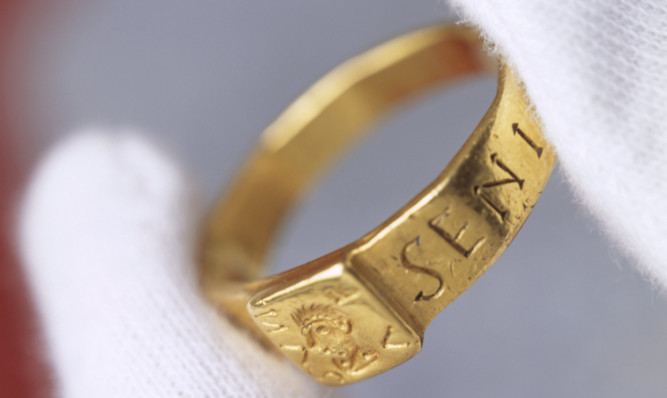An ancient gold ring which is believed to have inspired JRR Tolkien to write The Hobbit is to have its own exhibition for the first time.
The ring, which was found in a farmer’s field in 1785, is linked to a Roman curse tablet which echoes the legends created by Tolkien in his fantasy novels.
It is now to go on display at the National Trust property The Vyne in Hampshire where the ring, which is inscribed in Latin and inset with an image of the goddess Venus, lay forgotten in the library for many years.
The ring, which was found in a field in nearby Silchester, a Roman town with a famous excavation site, is inscribed with the words “Senicianus live well in God”.
In the early 19th century, a curse tablet was found at a Roman temple site in Lydney, Gloucestershire, about 80 miles away from The Vyne. Written on it was a plea from a Roman called Silvianus, asking Nodens, the god of the Lydney temple, to return a ring, stolen by Senicianus, and placing a curse of ill health on the thief.
The translation reads: “To the God Nodens. Silvianus has lost a ring … among those who bear the name of Senicianus to none grant health until he bring back the ring to the temple of Nodens.”
Archaeologist Sir Mortimer Wheeler, the director of later excavations at Lydney, realised the connection between the ring and the curse tablet, and in 1929 he asked Tolkien, who was Professor of Anglo-Saxon at Oxford University, to work on the etymology of the name Nodens.
Tolkien visited the Temple of Nodens on a number of occasions, and it is believed that he would have been made aware of the existence of the ring at this time and within a year he began writing The Hobbit.
Also, the area around the temple was known as Dwarf’s Hill, believed to have been an Iron Age fort containing mines which some suggest was the inspiration for the dwarves in The Hobbit.
How the ring came to reside at The Vyne is unknown but the owner, Chaloner Chute, included information about the ring in his history of the building in 1888.
The ring is larger than an average ring, with a diameter of 25mm and weighing 12g, and may have been made to wear on a thumb and over a glove.
It is probably 4th-century, has a 10-faceted hoop and a bezel mounted on the top engraved with an image of the goddess of Venus.
Dr Lynn Forest-Hill, education officer for the Tolkien Society, said: “We were delighted to partner the National Trust in this project and to assist with research that may shed further light on the history of this mysterious piece of gold.
“The result is a unique exhibition that delves into the ring’s past, and allows visitors to decide for themselves: is this The One Ring?
“The influences most often cited for Tolkien’s creation of The One Ring usually take the form of literary or legendary rings such as the Ring of the Nibelungs, or the old king’s ring in the 14th century story of Bevis of Hampton.
“It is, then, particularly fascinating to see the physical evidence of the Vyne Ring, with its links to Tolkien through the inscription associating it with a curse.
“It is well known that in 1929 Tolkien worked on the etymology of the name Nodens mentioned on a Roman curse stone.
“Significantly, in the context of his non-academic writing, he would have read the Latin inscription on the curse tablet: Deuo Nodenti Silvianus anilum perdidit …. inter quibus nomen Seniciani nollis permittas sanitatem perfera [t] translated as: To the god Nodens: Silvianus has lost a ring….among those who bear the name Senicianus to none grant health.”
Extending the Tolkien theme, The Vyne has transformed its gardens into an adventure playground based on Tolkien’s Middle-earth.
